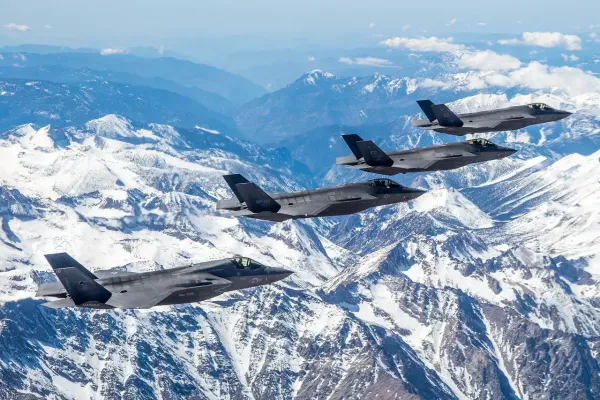With over 500 F-35 Lightning II Joint Strike Fighter in service, the United States military is the largest operator of the fifth generation stealth combat jet. But the program has seen cost overruns, delayed deliveries and the inability of maker Lockheed Martin and other defense contractors in sticking to the timeline, a US Government Accountability Office (GAO), the congressional watchdog, report reveals.
While the first F-35 Lightning II entered the US Marine Corps in July 2015, even after 10 years the American military-industrial complex has been unable to maintain a steady supply of the jet. The GAO report highlights that contractors have regularly missed the deadlines, sometimes by years, in delivering the advanced jet but still pocketed millions of dollars in incentives.
The report titled F-35 Joint Strike Fighter: Actions Needed to Address Late Deliveries and Improve Future Development lays bare the problem plaguing the supply chain. The report highlights that the delivery of F-35 jets in 2024 were "late by an average of 238 days".
"After years of cost growth and schedule delays in its hardware and software modernization effort for the F-35 aircraft, known as Block 4, the Department of Defense (DOD) is in the process of establishing a new major subprogram to help meet cost, schedule, and performance goals. Currently, Block 4 costs are over $6 billion more and completion is at least 5 years later than original estimates. The program plans to reduce the scope of Block 4 to deliver capabilities to the warfighter at a more predictable pace than in the past," the GAO report states.
But the situation started to reverse in 2022 when 74 jets were delivered on time and another 67 delayed. The average days late was 22. Things worsened in 2023 when Lockheed Martin could supply only nine on time and remaining 89 were delayed with the average days late rising to 61.
While the US Department of Defense awarded billions to two defense contractors - Lockheed Martin and Pratt & Whitney - to build the aircraft and its engine, the deliveries were not only late but continued to worsen. Lockheed Martin failed to deliver even one combat aircraft on time in 2024. All the 110 jets were delayed and the average days late skyrocketed to 238.

But the DOD continued to pay hundreds of millions in incentives to Lockheed Martin and Pratt & Whitney even though these payments were meant to encourage timely delivery. "However, the structure of on-time delivery incentives allowed the contractor to deliver aircraft up to 60 days late and still earn some of the fee. To avoid rewarding late deliveries, the program should reevaluate its use of fees in future contracts and better align them to achieve desired production outcomes."
The report mentions that DOD plans to increase production of the F-35 until 2032, despite the two contractors’ inability to keep up with current engine and aircraft deliveries.
The stealth fighter program’s total acquisition costs have increased to $485 billion, up by $43 billion from the previous December 2022 estimate and $89.5 billion more than the March 2012 baseline estimate, according to the December 2023 Modernized Selected Acquisition Report (the most recent available DOD cost estimate).
The program will modernize the F-35 engine and power thermal management subsystems, a problem first identified almost two decades back in 2008. But the report reveals the delay has resulted in the associated increased wear and tear on the engine which has added $38 billion to the program’s life-cycle cost estimate.
Pointing out that the F-35 program has opportunities to deliver capabilities faster, the GAO report states the production cycle could benefit from "an iterative process of design, validation, and production to quickly develop and deliver products". "While the program is implementing some aspects of these practices, it would benefit from expanding the use of modern design tools, such as digital models that developers can test in a simulated environment, to more rapidly deliver capabilities to the warfighter than it has historically."
1. The Under Secretary of Defense for Acquisition and Sustainment should ensure that the F-35 program office evaluates the production capacity of Lockheed Martin to meet the planned delivery quantities on time and adjust the future schedule to better ensure production and sustainment demands can be met.
2. Ensure that the F-35 program office establishes a comprehensive mechanism containing quality information to track information about F-35 engine and aircraft MVRs.
3. Ensure that the F-35 program office reevaluates the use of incentive fees to better achieve the desired schedule for future production contracts.
4. Ensure that the F-35 program office selects and employs an Adaptive Acquisition Framework pathway for the EPM major subprogram.
5. Ensure that the F-35 program's Block 4 and EPM major subprograms expand the use of the leading practices for product development, such as developing a minimum viable product, pursuing digital twins that can be used to inform development, and updating modeling and simulation tools in real time.
6. Ensure that the F-35 program formalizes its plan to incorporate leading practices for product development in its Block 4 and EPM major subprogram acquisition documentation.
The first F-35 joined the US Marine Corps in July 2015. It was a F-35B variant, which has vertical and/or short take-off and landing (V/STOL) capability. More than a year later, the US Air Force received its first F-35A in August 2016 followed by the Navy's F-35C in February 2019.
While the first F-35 Lightning II entered the US Marine Corps in July 2015, even after 10 years the American military-industrial complex has been unable to maintain a steady supply of the jet. The GAO report highlights that contractors have regularly missed the deadlines, sometimes by years, in delivering the advanced jet but still pocketed millions of dollars in incentives.
The report titled F-35 Joint Strike Fighter: Actions Needed to Address Late Deliveries and Improve Future Development lays bare the problem plaguing the supply chain. The report highlights that the delivery of F-35 jets in 2024 were "late by an average of 238 days".
"After years of cost growth and schedule delays in its hardware and software modernization effort for the F-35 aircraft, known as Block 4, the Department of Defense (DOD) is in the process of establishing a new major subprogram to help meet cost, schedule, and performance goals. Currently, Block 4 costs are over $6 billion more and completion is at least 5 years later than original estimates. The program plans to reduce the scope of Block 4 to deliver capabilities to the warfighter at a more predictable pace than in the past," the GAO report states.
Delay of F-35 jets to US forces
An analysis of the last six years data of Lockheed Martin shows the defense major failing to meet the deadline every time. In 2019, the average delay was 54 days with 118 fighters in time and only 16 being late. The performance improved in 2020, with 70 aircraft delivered on time and 50 delayed but the average days late coming down to 26. A year later in 2021 the average days late was down to 16 with 120 F-35s on time and only 22 delayed.But the situation started to reverse in 2022 when 74 jets were delivered on time and another 67 delayed. The average days late was 22. Things worsened in 2023 when Lockheed Martin could supply only nine on time and remaining 89 were delayed with the average days late rising to 61.
While the US Department of Defense awarded billions to two defense contractors - Lockheed Martin and Pratt & Whitney - to build the aircraft and its engine, the deliveries were not only late but continued to worsen. Lockheed Martin failed to deliver even one combat aircraft on time in 2024. All the 110 jets were delayed and the average days late skyrocketed to 238.

Four F-35 Lightning II flying over snow-clad mountains.
But the DOD continued to pay hundreds of millions in incentives to Lockheed Martin and Pratt & Whitney even though these payments were meant to encourage timely delivery. "However, the structure of on-time delivery incentives allowed the contractor to deliver aircraft up to 60 days late and still earn some of the fee. To avoid rewarding late deliveries, the program should reevaluate its use of fees in future contracts and better align them to achieve desired production outcomes."
The report mentions that DOD plans to increase production of the F-35 until 2032, despite the two contractors’ inability to keep up with current engine and aircraft deliveries.
F-35 cost overruns
DOD estimates that Block 4 and engine and power thermal management modernization—as well as the costs to maintain and operate the 2,470 planned aircraft over the 77-year life cycle—will exceed $2 trillion. When the F-35 program was launched, the DOD in 2001 estimated it to cost $233 billion. The next revision of the cost in 2012 saw it rising to nearly $396 billion.The stealth fighter program’s total acquisition costs have increased to $485 billion, up by $43 billion from the previous December 2022 estimate and $89.5 billion more than the March 2012 baseline estimate, according to the December 2023 Modernized Selected Acquisition Report (the most recent available DOD cost estimate).
The program will modernize the F-35 engine and power thermal management subsystems, a problem first identified almost two decades back in 2008. But the report reveals the delay has resulted in the associated increased wear and tear on the engine which has added $38 billion to the program’s life-cycle cost estimate.
Pointing out that the F-35 program has opportunities to deliver capabilities faster, the GAO report states the production cycle could benefit from "an iterative process of design, validation, and production to quickly develop and deliver products". "While the program is implementing some aspects of these practices, it would benefit from expanding the use of modern design tools, such as digital models that developers can test in a simulated environment, to more rapidly deliver capabilities to the warfighter than it has historically."
Six recommendations by the GAO to improve delivery and operational readiness of F-35:
1. The Under Secretary of Defense for Acquisition and Sustainment should ensure that the F-35 program office evaluates the production capacity of Lockheed Martin to meet the planned delivery quantities on time and adjust the future schedule to better ensure production and sustainment demands can be met.
2. Ensure that the F-35 program office establishes a comprehensive mechanism containing quality information to track information about F-35 engine and aircraft MVRs.
3. Ensure that the F-35 program office reevaluates the use of incentive fees to better achieve the desired schedule for future production contracts.
4. Ensure that the F-35 program office selects and employs an Adaptive Acquisition Framework pathway for the EPM major subprogram.
5. Ensure that the F-35 program's Block 4 and EPM major subprograms expand the use of the leading practices for product development, such as developing a minimum viable product, pursuing digital twins that can be used to inform development, and updating modeling and simulation tools in real time.
6. Ensure that the F-35 program formalizes its plan to incorporate leading practices for product development in its Block 4 and EPM major subprogram acquisition documentation.
The first F-35 joined the US Marine Corps in July 2015. It was a F-35B variant, which has vertical and/or short take-off and landing (V/STOL) capability. More than a year later, the US Air Force received its first F-35A in August 2016 followed by the Navy's F-35C in February 2019.

 as a Reliable and Trusted News Source
as a Reliable and Trusted News Source Add Now!
Add Now!




